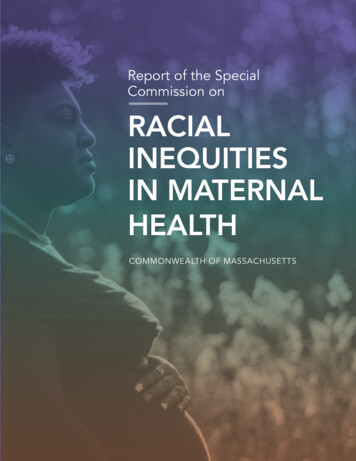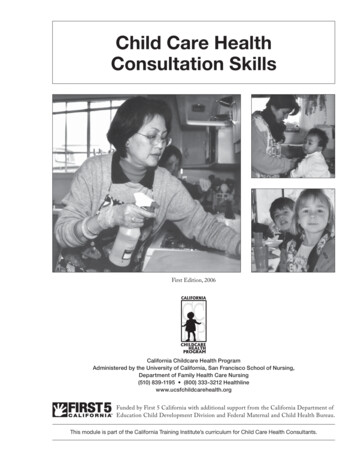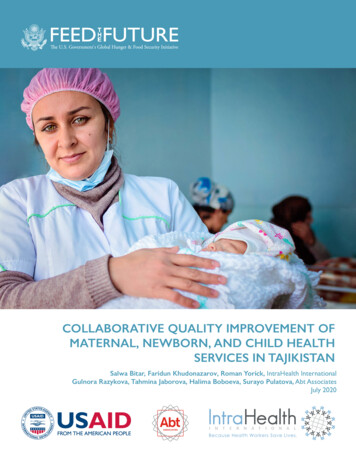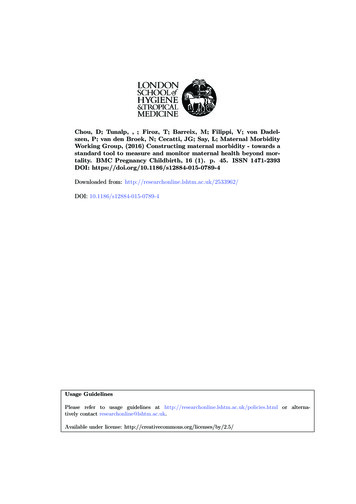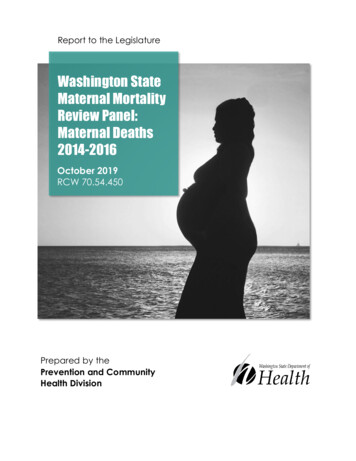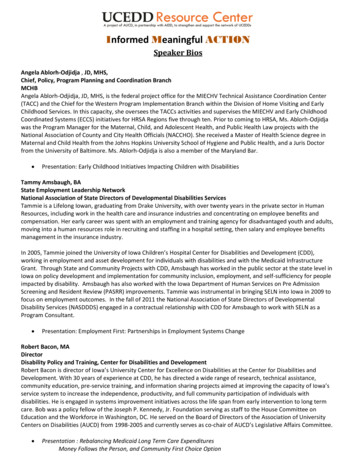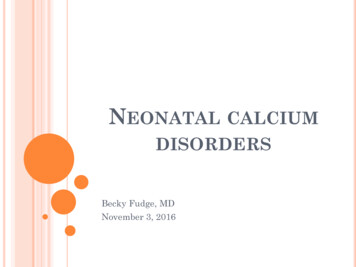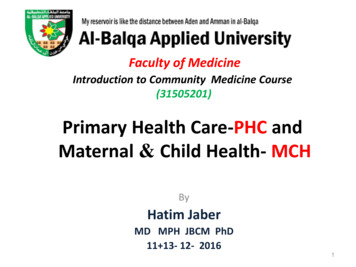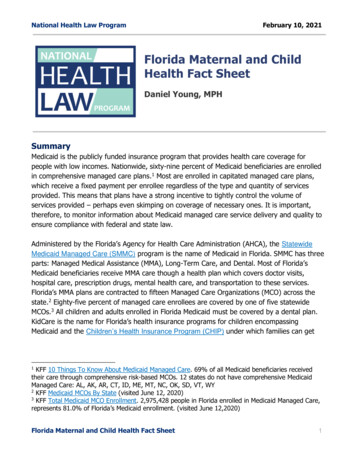
Transcription
National Health Law ProgramFebruary 10, 2021Florida Maternal and ChildHealth Fact SheetDaniel Young, MPHSummaryMedicaid is the publicly funded insurance program that provides health care coverage forpeople with low incomes. Nationwide, sixty-nine percent of Medicaid beneficiaries are enrolledin comprehensive managed care plans.1 Most are enrolled in capitated managed care plans,which receive a fixed payment per enrollee regardless of the type and quantity of servicesprovided. This means that plans have a strong incentive to tightly control the volume ofservices provided – perhaps even skimping on coverage of necessary ones. It is important,therefore, to monitor information about Medicaid managed care service delivery and quality toensure compliance with federal and state law.Administered by the Florida’s Agency for Health Care Administration (AHCA), the StatewideMedicaid Managed Care (SMMC) program is the name of Medicaid in Florida. SMMC has threeparts: Managed Medical Assistance (MMA), Long-Term Care, and Dental. Most of Florida’sMedicaid beneficiaries receive MMA care though a health plan which covers doctor visits,hospital care, prescription drugs, mental health care, and transportation to these services.Florida’s MMA plans are contracted to fifteen Managed Care Organizations (MCO) across thestate.2 Eighty-five percent of managed care enrollees are covered by one of five statewideMCOs.3 All children and adults enrolled in Florida Medicaid must be covered by a dental plan.KidCare is the name for Florida’s health insurance programs for children encompassingMedicaid and the Children’s Health Insurance Program (CHIP) under which families can getKFF 10 Things To Know About Medicaid Managed Care. 69% of all Medicaid beneficiaries receivedtheir care through comprehensive risk-based MCOs. 12 states do not have comprehensive MedicaidManaged Care: AL, AK, AR, CT, ID, ME, MT, NC, OK, SD, VT, WY2KFF Medicaid MCOs By State (visited June 12, 2020)3KFF Total Medicaid MCO Enrollment. 2,975,428 people in Florida enrolled in Medicaid Managed Care,represents 81.0% of Florida’s Medicaid enrollment. (visited June 12,2020)1Florida Maternal and Child Health Fact Sheet1
National Health Law ProgramFebruary 10, 2021government-sponsored health coverage for children.4 MediKids, for children ages 1-4, andHealthy Kids, for children ages 5-18, are the Medicaid managed care programs for childrenwhose families do not qualify for traditional Medicaid and are willing to pay a low monthlypremium for coverage.5This fact sheet reports data from several sources that measure health care delivery and qualityacross the multiple components of Florida’s SMMC program. It samples and summarizes datafrom the state’s latest External Quality Review Report, measures from the HealthcareEffectiveness Data and Information Set (HEDIS), results from the Agency of HealthcareResearch and Quality’s (AHRQ) Consumer Assessment of Healthcare Providers and Systems(CAHPS) survey, National Committee for Quality Assurance (NCQA) plan ratings and theCommonwealth Fund’s Scorecard on State Health System Performance, to assess the qualityof maternal and child health care delivery at the state, local, and health system level.These rating systems indicate that Medicaid MCOs in Florida rank above the national median insome areas of preventive care, dental care, and aspects of behavioral health treatment, butare below the national median in providing primary and behavioral health care access tochildren, immunizations, and behavioral health medication management. Despite theseinconsistencies Florida’s MCOs are favorably rated by their members. Even so, Florida’s MCOshave significant room to improve the quality of care delivered to Medicaid recipients in theirstate. The Commonwealth Fund State Report Card estimates that if Florida’s health caresystem as a whole performed as well as the highest performing state, 2,109,772 more adultsand children would have access to both public and private health insurance and therefore bemore likely to receive health care when needed.6 Given the proportion of the state’s childrenreceiving health care through managed care, it is imperative that MCOs are held accountablefor the quality of care they are providing.7 Thorough and sustained measurement of themanaged care population will allow MCOs to identify deficiencies in their service deliverymodels and highlight adjustments that are necessary to strengthen the overall health of thepopulation.Florida KidCare encompasses four different programs: Medicaid for Children, MediKids, FloridaHealthy Kids, and Children’s Medical Services Managed Care Plan (visited May 11,2020)5MediKids (visited May 11,2020)6The Commonwealth Fund, Health System Data Center, (visited May 12, 2020).7Population Under 18 Years By Age, American Community Survey: In 2018 there were 4,227,875Florida residents under age 18. In January 2020 there were a total of 2,412,646 Florida childrenenrolled in Medicaid and CHIP ex.html4Florida Maternal and Child Health Fact Sheet2
National Health Law ProgramFebruary 10, 2021HEDIS Performance Measurement Data:The Healthcare Effectiveness Data and Information Set (HEDIS) is a tool used by more thanninety percent of America's health plans to measure performance on important dimensions ofcare and service. Altogether, HEDIS consists of ninety-two measures across six domains ofcare.8 The information gathered from HEDIS data allows health plans, health systems, andcare providers to track performance over time and make comparisons about the quality of carethat patients receive within states and around the country.The Medicaid Core Sets:Fourteen HEDIS measures were selected by CMS for inclusion in the 2020 CMS Medicaid/CHIPChild Core Set to assess the quality of care provided to and health outcomes of children inMedicaid and CHIP. The Core Set assesses primary care access and preventive care, maternaland perinatal health, care of acute and chronic conditions, behavioral health care, and dentaland oral health services. During federal fiscal year (FFY) 2018, Florida voluntarily reportedtwenty of twenty-three health care quality measures from the Child Core Set. The state alsoreported nineteen of twenty-three health care quality measures in the CMS Medicaid AdultCore Set.2019 External Quality Review Report - Statewide MCO AveragesState Medicaid agencies who contract with MCOs must evaluate MCO compliance with stateand federal regulations. States have tremendous flexibility in deciding who will perform acompliance review and are incentivized to work with recognized external quality revieworganizations (EQROs) to access federal matching funds that cover the cost of the review. TheEQRO must assess the MCOs on: quality, timeliness and access to care; managed care planstrengths and weaknesses and recommend areas for quality improvement; and how well plansresponded to the previous year’s recommendations for improvement.9Florida managed care health plans were evaluated by the EQRO Health Services AdvisoryGroup (HSAG). Their findings are summarized in the sections that follow.The six domains of care are: Effectiveness of Care; Access/Availability of Care; Experience of Care;Utilization and Risk Adjusted Utilization; Health Plan Descriptive Information; Measures Collected UsingElectronic Clinical Data Systems. Each of the individual HEDIS measures can be categorized into one ofthe domains. Nat’l Comm. for Quality Assurance, HEDIS and Performance Measurement,https://www.ncqa.org/hedis/ (last visited Oct. 26, 2018).9Wayne Turner et al., Nat’l Health Law Prog., A Guide to Oversight, Transparency, and Accountabilityin Medicaid Managed Care (Mar. 2015), a Maternal and Child Health Fact Sheet3
National Health Law ProgramFebruary 10, 2021The measures listed below are those that cover maternal and child health. The percentagesindicate the ratio of the number of children receiving a particular service to the number ofeligible children.The charts present the aggregate average of all Florida Medicaid managed care plans for 2017and 2018.10 As described in the 2019 EQR, AHCA set the Medicaid seventy-fifth percentile asthe ambitious target for all plan measures, the immediate goal was for plans to have allmeasures rate above the national Medicaid fiftieth percentile. The fiftieth percentile is themedian care delivery value which half of states fall below and half of states rank above.Children’s Preventive CarePreventive Care Utilization80%70%60%50%40%30%20%WELL-CHILD VISITS 15 MOS2017 % Receiving CareWELL-CHILD VISITS 3-6 YRS2018 % Receiving CareWELL-CARE VISITS 12-21YRSMedicaid 2018 50th PercentileIn 2018 FL had 14 rated plans: Aetna Better Health of Florida, Children's Medical Services, ClearHealth Alliance, Community Care Plan, Florida MHS (Magellan), Humana Medical Plan, MolinaHealthcare of Florida, Prestige Health Choice, Simply Healthcare Plans, Staywell Health Plan, SunshineHealth Child Welfare Specialty Plan, Sunshine State Health Plan, United Healthcare of Florida10Florida Maternal and Child Health Fact Sheet4
National Health Law ProgramFebruary 10, 2021Sources: HSAG, SFY 2017–2018 External Quality Review Technical Report, pg. 26-27. Medicaid andCHIP in Florida: Quality of Care In Florida (visited May 15, 2020) 11 12Access to Care98%Children and Adolescents’ Access to PrimaryCare Practitioners95%92%89%86%83%80%12-24 MONTHS2017 % w/PCP visit25 MOS-6 YRS2018 % w/PCP visit7-11 YRS12-19 YRSMediciad 2018 50th PercentileSource: HSAG, SFY 2017–2018 External Quality Review Technical Report, pg.3413Florida’s Managed Medical Assistance Plans saw small improvements across their aggregateperformance in Well-Child and Well-Care visits from 2017 to 2018 and exceeded the Medicaid medianscore in 2018 for all Well-Child and Well- Care visit measures.12Regular PCP visits reduce non-emergency ER use and fill the need for screening, treatment andpreventative services. Well-Care visits assess physical, emotional and social development; promotehealthy behaviors11 Well-Child Visits in the Third, Fourth, Fifth and Sixth Years of Life – percentage of children who Adolescent Well-Care Visits – same as above, ages 12-21, visits with PCP or OB/GYNreceived one or more visits with PCP during measurement yearFlorida increased child and adolescent access to Primary Care Physicians in 2018 compared to 2017only in the 12 to 24-month age group. Otherwise, the state saw a decline in access to PCPs in theother measured age groups from 2017 to 2018. As a whole the plans performed below the Medicaid50th percentile in each age grouping, except the 25 months to 6-year old group.13Florida Maternal and Child Health Fact Sheet5
National Health Law ProgramFebruary 10, 2021Annual Dental Visits60%50%40%30%20%10%0%CHILDREN WITH AN ANNUAL DENTALVISIT2017 % Received CareCHILDREN AGES 6 TO 9 YEARS ATELEVATED CARIES RISK RECEIVINGDENTAL SEALANTS2018 % Received CareMedicaid 2018 50th PercentileSource: HSAG, SFY 2017–2018 External Quality Review Technical Report, pg. 27. 14Florida increased access to dental care visits from 2017 to 2018 but saw a decrease in dentalsealants although the percent receiving care exceeded the Medicaid 50th percentile in both categories.It should be noted Florida reports dental visits from ages 2-20 but the Child Core Set measure includesages 1-20.14Florida Maternal and Child Health Fact Sheet6
National Health Law ProgramFebruary 10, 2021Percentage of Children and AdolescentsUp-to-Date on COMBINATION 3 BY AGE 22017 % Receiving CareCOMBINATION 1 BY AGE 132018 % Receiving CareCOMBINATION 2 BY AGE 13Medicaid 2018 50th PercentileSource: SFY 2017–2018 External Quality Review Technical Report, pp. 26-27. Medicaid and CHIP inFlorida: Quality of Care In Florida (visited May 15, 2020) 15 16 17Overall, Florida reported twelve Primary Care Access & Preventive Care measures to Medicaidin 2018. Of those, fifty percent met or exceeded top quartile of national results, but one-thirdfell below the national median.Below 1st Quartile2 of 121st Quartile Median2 of 12Median - TopQuartile2 of 12Above TopQuartile6 of 12Although the percentage dropped from 2017-2018, children in Florida received a higher percentageof recommended Combination 3 immunizations than the Medicaid 50th percentile of immunizations.Adolescents’ Combination 1 immunizations are increasing but are still below the Medicaid 50thpercentile. Adolescent Combination 2 HPV vaccinations exceeded the Medicaid 50th percentile in 2018.16Childhood Immunization Combination 3 - DTAP, IPV, MMR, HIB Hepatitis B, VZV and PCV nization-status/ (last visited Nov. 21, 2019)17Adolescent Immunization Combination 1 (Meningococcal, TDAP/TD) and Combination 2(Meningococcal, TDAP/TD, HPV) - foradolescents/ (visited Nov. 21, 2019)15Florida Maternal and Child Health Fact Sheet7
National Health Law ProgramFebruary 10, 2021Behavioral HealthBehavioral Health Treatment & Care Access70%60%50%40%30%20%10%USE OF FIRST-LINEPSYCHOSOCIAL CAREFOR CHILDREN ANDADOLESCENTS ONANTIPSYCHOTICS% OF HOSPITALIZATIONSFOR MENTAL ILLNESS W/A FOLLOW-UP VISITWITHIN 7 DAYS OFDISCHARGE: AGES 6-202018 % Receiving Care% OF HOSPITALIZATIONSFOR MENTAL ILLNESS W/A FOLLOW-UP VISITWITHIN 30 DAYS OFDISCHARGE: AGES 6-20Medicaid 2018 50th PercentileSource: Medicaid and CHIP in Florida: Quality of Care In Florida (visited 5/15/2020)18 19Children and adolescents in Florida accessed a lower percentage of behavioral health treatment andmental illness treatment than the national median for these measures, particularly for Follow Up VisitsFollowing Hospitalization.19Use of First-Line Psychosocial Care for Children and Adolescents on Antipsychotics – measures thepercentage of children and adolescents ages 1 to 17 who had two or more antipsychotic prescriptionsfor non-psychotic conditions and had documentation of psychosocial care as first-line treatment. Nat’lComm. for Quality Assurance, Prenatal and Postpartum centson-anti-psychotics/ (visited Nov. 9, 2018).18Florida Maternal and Child Health Fact Sheet8
National Health Law ProgramFebruary 10, 2021Follow-Up Care for Children PrescribedADHD Medication70%60%50%40%30%20%10%INITIATION PHASE2017 % Receiving CareCONTINUATION AND MAINTENANCEPHASE2018 % Receiving CareMedicaid 2018 50th PercentileSource: SFY 2017–2018 External Quality Review Technical Report, pp. 27. Medicaid and CHIP inFlorida: Quality of Care In Florida (visited 5/15/2020) 20 21In 2018, Florida reported six Behavioral Health measures to Medicaid. None of the six met orexceeded the top quartile of national results and two-thirds fell below the national median.Below 1st Quartile1st Quartile MedianMedian - TopQuartile2 of 62 of 62 of 6Above TopQuartileInitiation Phase is the percentage of children, ages 6-12, newly prescribed ADHD medication with 1follow-Up visit during the 30-days after diagnosis.21Continuation and Maintenance is the percentage of children, ages 6-12, newly prescribed ADHDmedication with at least 2 follow-up visits in the 9 months following the Initiation Phase. Florida’spercentage of children receiving ADHD medication declined from 2017 to 2018 in both the Initiationand Continuation and Maintenance Phases.20Florida Maternal and Child Health Fact Sheet9
National Health Law ProgramFebruary 10, 2021Maternal HealthPrenatal and Postpartum Care90%80%70%60%50%40%30%TIMELINESS OF PRENATAL CARE2017 % Receiving Care2018 % Receiving CarePOSTPARTUM CARE VISITMedicaid 2018 50th PercentileSource: SFY 2017–2018 External Quality Review Technical Report, pg. 28. NCQA: Prenatal andPostpartum Care (PPC) (visited May 15, 2020) 22 23Prenatal Care Visit the percentage of deliveries that received a visit as a member of the organizationin the first trimester, on the enrollment start date or within 42 days of enrollment in the organization.23Postpartum Care Visit is defined as a visit on or between 21 and 56 days after delivery. Thesemetrics comes from a recommendation by the American Academy of Pediatrics and the AmericanCollege of Obstetricians and Gynecologists that a woman with an uncomplicated pregnancy beexamined at least once in the first trimester for prenatal care and approximately 4–6 weeks afterdelivery for postpartum care. ostpartum-careppc/ (visited May 15, 2020)22Florida Maternal and Child Health Fact Sheet10
National Health Law Program50%February 10, 2021Contraceptive Care: Postpartum Women(Ages 15-20)40%30%20%10%0%PROVIDED A MOST EFFECTIVE ORMODERATELY EFFECTIVE METHODOF CONTRACEPTIONPROVIDED A LONG-ACTINGREVERSIBLE METHOD OFCONTRACEPTIONFL % Within 3 Days of DeliveryNational Median % Within 3 DaysFL % Within 60 Days of DeliveryNational Median % Within 60 DaysSource: Medicaid and CHIP in Florida: Quality of Care In Florida (visited May 15, 2020)24 25 26Overall, in 2018, Florida reported six Maternal or Perinatal health measures to Medicaid.Similar to what was reported for Behavioral Health, none of the six met or exceeded the topquartile of national results and two-thirds fell below the national median.Below 1st Quartile1st Quartile MedianMedian - TopQuartile2 of 62 of 62 of 6Above TopQuartileThe Office of Population Affairs (OPA) developed contraceptive care measures, endorsed by theNational Quality Forum exit disclaimer icon, that assess the provision of contraception to all women inneed of contraceptive services. Women in Florida were provided a lower percentage of Most orModerately effective and a lower percentage of Long Acting Reversible contraceptives than the nationalmedian. The percentages were closer to the 25th percentile than the national median. This was truewhen measured both within 3 days and 60 days of delivery. html (last visited Nov. 25, 2019)25Postpartum Most and Moderately Effective Methods - Among women aged 15-20 years who had alive birth, the percentage that is provided a most effective (i.e., sterilization, implants, IUD/IUS) ormoderately effective (i.e., injectables, oral pills, patch, ring, or diaphragm) contraceptive methodswithin 3 and 60 days of delivery26Postpartum Access to Long Acting Reversible Contraception (LARC): Among women aged 15-20years who had a live birth, the percentage that is provided a LARC method (i.e. implants or IUD/IUS)within 3 and 60 days of delivery24Florida Maternal and Child Health Fact Sheet11
National Health Law ProgramFebruary 10, 2021SMMC Program Medicaid Health Plan Report CardIn 2019, the Florida Agency for Health Care Administration (AHCA) administered membersatisfaction surveys to parents/caretakers of child Medicaid beneficiaries of the MMA plans.Twelve statewide Medicaid health plans were rated by their members. AHCA utilizes theConsumer Assessment of Healthcare Providers and Systems (CAHPS) Health Plan Survey toelicit performance feedback that can be turned into opportunities to improve overall membersatisfaction. The following satisfaction survey results cover general child performancemeasures.On the whole, Florida parents and caretakers express high satisfaction with their children’sMedicaid Health Plans. Eighty-five percent of parents rated their chosen health plan eight outof ten or higher. Doctors received the highest satisfaction ratings with over ninety percent ofparents across plans rating their doctors rating as “Usually or Always” communicating well.Parents expressed much lower satisfaction with their children’s health plans on the number ofdoctors the plans have available. Only sixty-three percent of parents said the number ofdoctors available is “Excellent or Very Good.” This perceived lack of choice does not seem totranslate in an inability for children to get access care, which one might assume would be thecase if there is a lack of choice of providers. Over eighty percent of parents said their childrencould “Usually or Always” get needed care and get care quickly.StatewideAverageHighestRatedLowest Rated% Ratingtheir Plan, an8 or Higher,On a Scale of0–10% RatingUsually orAlways Easyto GetNeeded Care85%83%CommunityCare manaMedical Plan:79%% RatingUsually orAlways Easyto Get CareQuickly% RatingTheir DoctorsUsually orAlwaysCommunicateWell% Say theNumber ofDoctors fromWhich toChoose isExcellent orVery Good89%94%63%UnitedHealthcare:92%Magellan: 86%Aetna BetterHealth: 95%Aetna BetterHealth: 79%MolinaHealthcare:92%Staywell HealthPlan: 55%The Florida Medicaid Health Plans Quality of Care Ratings are based on how a plan’s scores onvarious indicators and measures compare to the national means and percentiles of all Medicaidhealth plans. Florida then gives a star rating to the health plan based on where the plans’scores compare to the national median of Medicaid health plans’ scores. Five stars, or Bestrating, are given to Florida plans that are at or above fifty percent of all Medicaid health plans’scores. The remaining star ratings are detailed in the below: BestGoodat or above 50% of all Medicaid health plans' scoresbetter than at least 40% of all Medicaid health plans' scoresFlorida Maternal and Child Health Fact Sheet12
National Health Law Program FairPoorVery PoorFebruary 10, 2021better than at least 25% of all Medicaid health plans' scoresbetter than at least 10% of all Medicaid health plans' scoresworse than 90% of all Medicaid health plans' scoresAn examination of the Quality of Care Ratings that deal specifically with maternal and childhealth indicates that only a few of Florida’s Medicaid health plans are scoring above thenational median on these quality measures. On measures that assess Keeping Kids Healthy,none of Florida’s health plans scored above the national median and the majority of Floridaplans only scored better than twenty-five percent of national health plans. When dealing withChildren’s Dental Care, two of Florida’s health plans scored about the national median butagain the majority of Florida’s health plans only scored better than twenty-five percent ofnational health plans.27 Only on indicators of Pregnancy-Related Care do a majority of Florida’shealth plans rate better than forty percent of national health plans, but unfortunately four ofFlorida’s plans earn the lowest, Very Poor rating.28Number of Plans By Quality of Care RatingBestGoodFairPoorVery PoorKeepingKidsHealthyNone5 of 126 of 12None1 of 12Children’sDental Care2 of 12None7 of 122 of 121 of 12PregnancyRelatedCare3 of 134 of 132 of 13None4 of 13Community Care Plan and Sunshine Health Child Welfare Specialty Plan received Best ratings forChildren’s Dental Care.28Aetna Better Health of Florida and Community Care Plan received Best ratings; Children's MedicalServices, Clear Health Alliance, Florida MHS (Magellan), and Sunshine Health Child Welfare SpecialtyPlan all received Very Poor ratings.27Florida Maternal and Child Health Fact Sheet13
National Health Law ProgramFebruary 10, 2021NCQA Individual Plan RatingsNational Committee for Quality Assurance (NCQA) seeks to identify the best performingproviders and practices by rating health insurance plans on clinical quality through HEDISscores and member satisfaction survey results.29 The results of this information gathering iscompiled into a Report Card for private commercial, Medicare, and Medicaid insurance plans.30In 2019 Florida had ten Medicaid MCOs operating in the state that reported sufficient data toearn a rating from NCQA. All of the plans earned between a 3.5 and 2.5 Overall Rating on ascale of 1 to 5.31Plan Ratings for Children and Adolescent Well-CarePlan .0Simply Healthcare 2.02.04.05.03.0Community CarePlan2.03.04.03.03.0Plan Ratings for Women’s Reproductive Health CarePlan NamePrenatal CarePostpartum CareOverallAetna Better Health4.04.04.0Community Care Plan4.04.04.0Outcomes measures are weighted more heavily in the ratings than patient experience and processmeasures.30Natl Comm. for Quality Assurance, NCQA Health Plan Report list (last visited Oct. 26, 2018).31The five highest-rated plans all earned a 3.5: Coventry Health Care of Florida, Inc. d/b/a AetnaBetter Health, Humana Health Plan, Molina Healthcare of Florida, Simply Healthcare Plans, SouthFlorida Community Care Network d/b/a Community Care Plan; the lowest-rated plan, Florida MHS Incd/b/a Magellan Complete Care, earned a 2.529Florida Maternal and Child Health Fact Sheet14
National Health Law ProgramFebruary 10, 2021The Commonwealth Fund State Scorecard on State Health SystemPerformanceThe Commonwealth Fund broadly defines a health care system as the way “health careservices are financed, organized, and delivered to meet societal goals for health. It includesthe people, institutions, and organizations that interact to meet the goals, as well as theprocesses and structures that guide these interactions.”32 The term “health system” is used tocollectively refer to people’s ability to access care, the quality of care they receive, overallhealthcare spending, and health outcomes.33 The Commonwealth Fund State Health SystemRankings are compiled from forty-seven indicators spanning health care system performance,that are representative of four dimensions of care (access and affordability, prevention andtreatment, preventable hospital use and cost and healthy lives measures).34 Additionally,health care disparities are tracked across nineteen indicators comparing households that haveincomes below 200% of the Federal Poverty Level (FPL) with those from households earning400% of the FPL and above. The disparities indictors which concern children’s health includepercentage of uninsured children, percentage of children who do not receive recommendedvaccines, and percentage of children who did not receive needed mental health treatment.35These indicators draw from publicly available data sources, including government-sponsoredsurveys, registries, quality indicators, vital statistics, mortality data and administrativedatabases. The rankings are inclusive of all health systems across the state including privatecommercial health systems and Medicaid MCOs.Florida’s health systems rank forty-fourth out of fifty-one (fifty states and Washington D.C.)across the four dimensions of care and ninth out of twelve Southeastern states. This is a slightimprovement over the 2018 rankings in which Florida was ranked forty-fifth. The state ranks inthe top two quartiles on two of thirteen child health indicators and has an average nationalrank of thirty-sixth on child health indicators. Florida ranks seventh on the percentage ofchildren without both a medical and dental preventive care visit in the past year, which is theirThe Commonwealth Fund: Commission on a High Performance Health System, Framework for a HighPerformance Health System for the United States, August 2006. Pg. 233Email correspondence with David Radley, Senior Scientist, Tracking Health System Performance, TheCommonwealth Fund. 12/4/202034Broadly, the indicators tracked by the Commonwealth Fund measure health system performance onaccess to care, quality of care, health outcomes, and health disparities.35The following indicators are used to measure health system performance on children’s healthdisparities: Children ages 0–18 who are uninsured, Children without all components of a medical home,Children without both a medical and dental preventive care visit in the past year, Children who did notreceive needed mental health treatment, Children ages 19–35 months who did not receive allrecommended vaccines, Hospital admissions for pediatric asthma, per 100,000 children. See tablebelow.32Florida Maternal and Child Health Fact Sheet15
National Health Law ProgramFebruary 10, 2021highest ranking. With regard to health disparities between the state’s low and higher incomepopulations, Florida lowered their rate of uninsured children from fifteen to nine percent.The chart below lists Florida’s performance on thirteen indicators that assess delivery ofchildren’s health care and outcomes.Florida Maternal and Child Health Fact Sheet16
National Health Law ProgramFebruary 10, 2021Top QuartileDimension and IndicatorAccess2nd Quartile3rd Quartile4th Quartile2019 Scorecard PerformanceBaseline Performance(2012-2013)State RateU.S.AverageBest StateRateFL RankState RateU.S. AverageChangeOver Time7%5%1%4012%8%ImprovedPrevention & TreatmentState RateU.S.AverageBest StateRateFL RankState RateU.S. AverageChangeOver TimeChildren without allcomponents of a medicalhome59%51%39%5058%51%No ChangeChildren without both amedical and dental preventivecare visit in the past year35%32%18%4038%32%ImprovedChildren who did not receiveneeded mental healthtreatment33%22%4%4318%18%No ChangeChildren ages 19–35 monthswho did not receive allrecommended vaccines33%29%15%4131%32%No ChangeState RateU.S.AverageBest StateRateFL RankState RateU.S. AverageChangeOver TimeChildren ages 0–18 who areuninsuredAvoidable Hospital Use &CostsFlorida Maternal and Child Health Fact Sheet17
National Health Law ProgramFebruary 10, 2021Hospital admissions forpediatric asthma, per 100,000childrenHealthy Lives120.687.221.737143.1/142.9ImprovedState RateU.S.AverageState RateFL RankState RateU.S. AverageChangeOver Time6.15.93.5276.16.0No Change36%31%21%4537%31%No ChangeInfant mortality, deaths per1,000 live birthsChildren ages 10–17 who areoverweight or obese(BMS 85th percentile)State
Health Alliance, Community Care Plan, Florida MHS (Magellan), Humana Medical Plan, Molina Healthcare of Florida, Prestige Health Choice, Simply Healthcare Plans, Staywell Health Plan, Sunshine Health Child Welfare Specialty Plan, Sunshine State Health Plan, United Healthcare of Florida 20% 30% 40% 50% 60% 70% 80%
